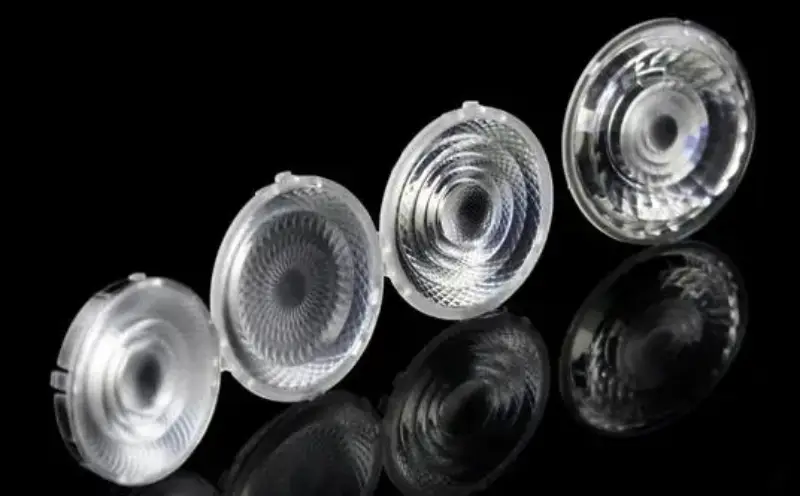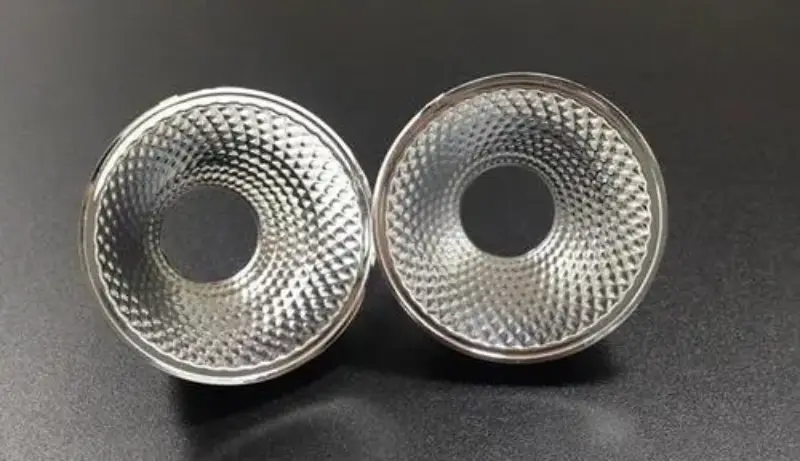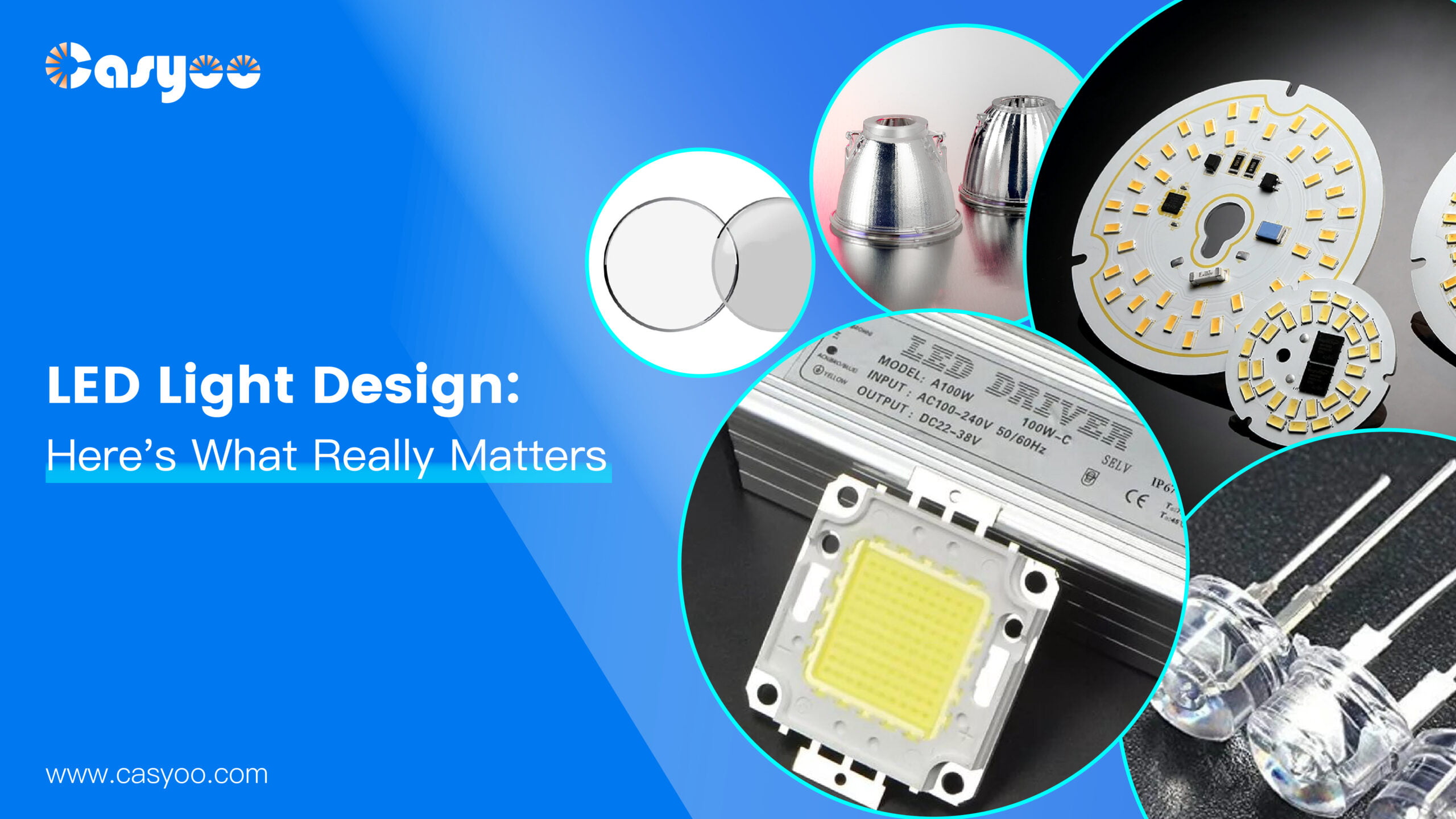LED lights surpass other light sources in terms of energy efficiency, brightness, lifespan, and so on. But choosing bad LED lights can also result in terrible lighting. How do you prevent making the wrong choices when purchasing LED lights? Knowing more about LED light design can help! If you know the LED lights as well as manufacturers do, what are other things to worry about? Read this simple but comprehensive guideline on LED light design and choose the best LED lights!
Structure and configuration of LED lights
Most LED lights consist of LED lamp beads, LED drivers, controllers, sensors, lenses, reflectors, PCBs, heat sinks, and housing.
- LED lamp beads: They are composed of LED chips, bond wires, epoxy lens, and frames. The chips can be packaged with DIP, SMD, and COB technology, among which COB packaging is the most advanced and beneficial. Typical LED chip models are listed in the following table.
| Model name | Power (W) | Brightness (lm) |
| 3528 | 0.0625 | 7-8 |
| 3014 | 0.1 | 11-12 |
| 2835/5050 | 0.2 | 20-22 |
| 5630 | 0.5 | 50-55 |
| High power | 1 | 110-120 |
- LED drivers: Since the LED lights are nonlinear fixtures, they need constant current power supplies. This kind of driver can keep the current stable when the voltage or number of LED lights changes, ensuring the reliability and efficiency of LED lights. The most popular constant-current power supplies apply capacitors to stabilize the current flow.
- Controller and sensors: The controller can change the electrical signal strength and current to realize the dimming of LED lights. Similarly, for RGB LEDs, the controllers change the brightness of different colors to produce the desired color. Besides the basic dimming and color changing, controllers can also realize smart control by integrating various sensing technologies, signal intelligent processing technology, and electronic control technology into one system. The controllers function as the CPU of LED lights.
- Lenses and reflectors: The light emitted by the LED chip is diffuse, and the beam angle is often 120°. Without optical design, the light will be too dazzling, and its direction cannot be controlled to illuminate desired areas. So applying secondary optical components like lenses and reflectors is necessary to concentrate the light.


Factors that should be considered for LED light design
Voltage and current
The color of LED lights is commonly used to determine voltage. The rated voltage of most blue LED lights is between 2.8 and 3.4 volts. Red LED lights have a rated voltage of 1.8–2.4 V. And the rated voltage of a single-chip white LED light ranges from 3.2 to 3.7 V. LED lights typically have a rated current of 20 mA. When these low-power LED lights are connected to the mains, resistors and capacitors can work to lower the voltage. But high-power LED lights require a constant-current driver circuit. The current consumption of 1W LED lights can be 350 mA, whereas 3W LED lights can draw 700 mA.
Beam angle
There are LED lights with different beam angles, which include 8°, 15°, 25°, 45°, 60°, 90°, 120°, and so on. They are used for different applications. Beam angle is classified as narrow when it is smaller than 20°, medium between 20° and 40°, and wide when it is bigger than 40°. The bigger the beam angle, the more areas the light can cover, and the softer the light is. On the contrary, despite smaller illumination areas, a narrower beam angle is applied where more concentrated and bright light is needed.
Efficiency
LED lights are known for their high efficiency, which is related to many factors:
- For LED lights with the same packaging and specifications, the lower the drive current, the higher the efficiency.
- Those LED lights with a lower voltage at the PN junction will have higher efficiency.
- Better heat dissipation design can ensure high efficiency. LED lights can be more efficient at lower temperatures.
Color temperature
As we all know, LED lights are different from other light sources because they have different color temperatures, which include white, warm white, and cool white. It is also possible to change the color temperature of a single RGB LED light by controlling the current and separately adjusting the brightness of the red, green, and blue lights. But generally, the color temperature is decided before producing, so you need to think about what color temperature can bring the optimal lighting effect to your space at the beginning.
Heat dissipation
Typical methods of dissipating heat include:
- Aluminum heat sink fins: This is the most popular method of heat dissipation for LED lights. Applying aluminum heat sink fins as a part of the casing can increase the heat dissipation area.
- Thermally conductive plastic shell: Filling the shell with the shell with thermally conductive material while molding can improve the shell’s ability to conduct and dissipate heat.
- Air hydrodynamics heat dissipation: Creating convection air by taking advantage of the shape of the lamp is the lowest-cost way to dissipate heat.
- Fans: Using fans inside the lamp housing is cheap and effective, but replacing them is troublesome. Therefore, it is not suitable for outdoor lights and is a rare way to dissipate heat.
- Heat pipe: The heat pipe conducts heat generated by the chip to the fins. It is also applied to large lighting fixtures like LED street lights.
- Surface radiation heat dissipation: After applying radiation heat dissipation paint, the radiation can take the heat away from the surface.
Frequently asked questions for LED light design
- Should LED lights be wired in series or parallel?
For low-power LED lights, they can be wired in pure series or parallel because the circuit design of the low-power driver is relatively simple. As for high-power LED lights, they will use a series and parallel hybrid circuit to get the best voltage and current settings.
- Do LEDs need resistors?
If the power supply is a constant-current one, there is no need to add resistors to the circuit. But if not, applying resistors can help reduce the current to ensure the constant illumination and long lifespan of LED lights.
Conclusions
What really matters for LED light design? The answer is knowing the structure well, choosing the suitable components, and knowing what features affect the LED lights most. We hope this passage provides you with more aspects to consider while choosing LED lights. Contact the professional consultants at Casyoo for more useful advice!




